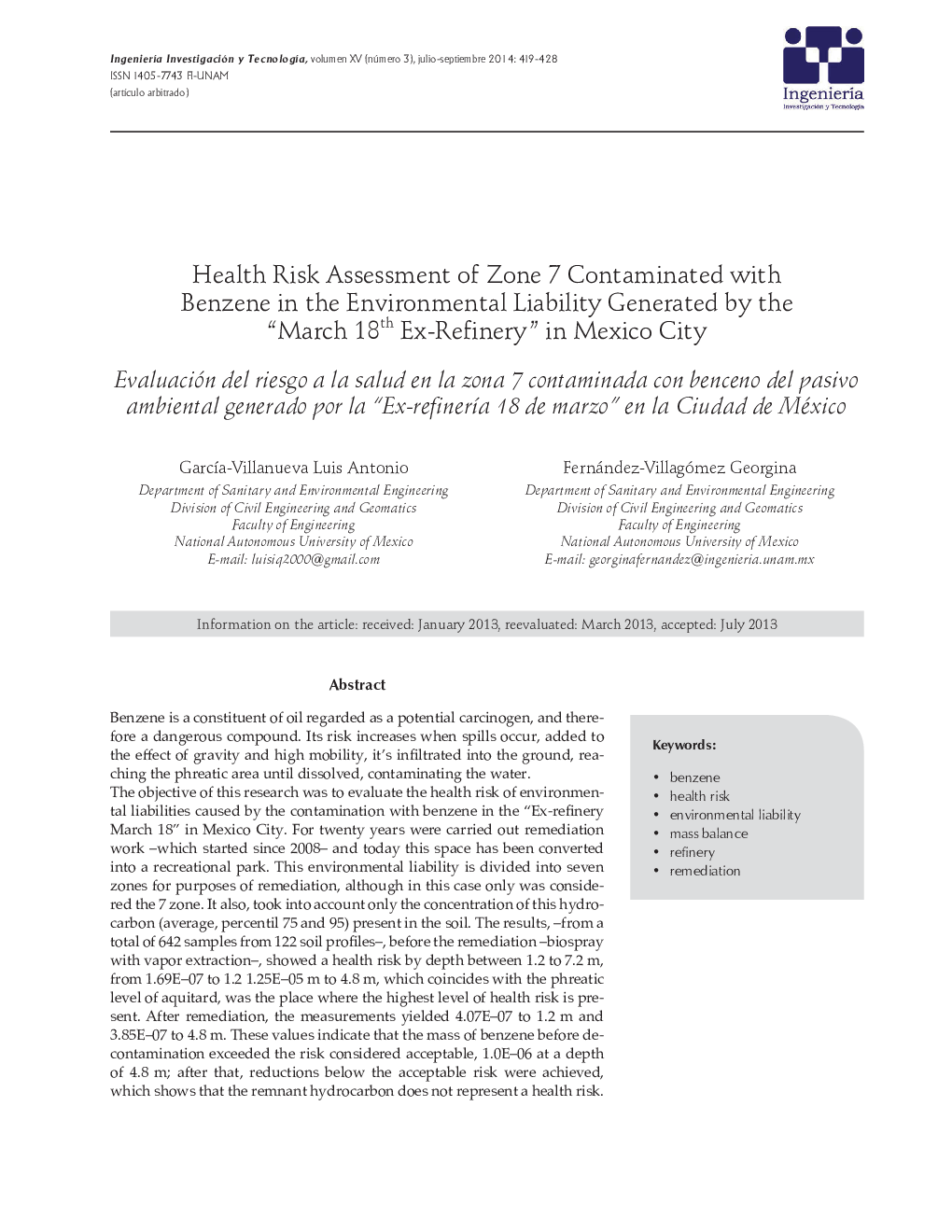| کد مقاله | کد نشریه | سال انتشار | مقاله انگلیسی | نسخه تمام متن |
|---|---|---|---|---|
| 274949 | 505387 | 2014 | 10 صفحه PDF | دانلود رایگان |

Benzene is a constituent of oil regarded as a potential carcinogen, and therefore a dangerous compound. Its risk increases when spills occur, added to the effect of gravity and high mobility, it's infiltrated into the ground, reaching the phreatic area until dissolved, contaminating the water.The objective of this research was to evaluate the health risk of environmental liabilities caused by the contamination with benzene in the “Ex-refinery March 18” in Mexico City. For twenty years were carried out remediation work –which started since 2008– and today this space has been converted into a recreational park. This environmental liability is divided into seven zones for purposes of remediation, although in this case only was considered the 7 zone. It also, took into account only the concentration of this hydrocarbon (average, percentil 75 and 95) present in the soil. The results, –from a total of 642 samples from 122 soil profiles–, before the remediation –biospray with vapor extraction–, showed a health risk by depth between 1.2 to 7.2 m, from 1.69E–07 to 1.2 1.25E–05 m to 4.8 m, which coincides with the phreatic level of aquitard, was the place where the highest level of health risk is present. After remediation, the measurements yielded 4.07E–07 to 1.2 m and 3.85E–07 to 4.8 m. These values indicate that the mass of benzene before decontamination exceeded the risk considered acceptable, 1.0E–06 at a depth of 4.8 m; after that, reductions below the acceptable risk were achieved, which shows that the remnant hydrocarbon does not represent a health risk.
ResumenEl benceno es un constituyente del petróleo que se considera un cancerígeno potencial y, por lo tanto, un compuesto peligroso. Su riesgo aumenta cuando ocurren derrames que, por efecto de la gravedad y su gran movilidad, se infiltran en el subsuelo, alcanzando la zona freática hasta disolverse, contaminando el agua.El objetivo de esta investigación fue evaluar el riesgo a la salud del pasivo ambiental producido por la contaminación con benceno en la “Ex-refinería 18 de marzo” en la Ciudad de México. Por veinte años no se llevaron a cabo trabajos de remediación–fueron iniciados a partir del año 2008– y hoy en día este espacio se ha convertido en un parque de recreación. Tal pasivo está dividido en siete zonas para fines de remediación, aunque para este caso solo se consideró la zona 7. Asimismo, se tomó en cuenta únicamente la concentración de este hidrocarburo (promedio, percentiles 75 y 95) presente en el suelo. Los resultados –provenientes de un total de 642 muestras de 122 perfiles de suelo–, antes de la remediación-bioaspersión con extracción de vapores– mostraron un riesgo a la salud por profundidad entre 1.2 a 7.2 m, de 1.69E–07 a 1.2 m y 1.25E–05 a 4.8 m, lo que coincide con el nivel freático del acuitardo, siendo este último el lugar donde se tiene el mayor nivel de riesgo a la salud. Después de la remediación, las mediciones arrojaron 4.07E–07 a 1.2 m y 3.85E–07 a 4.8 m. Estas cifras indican que la masa de benceno antes de la descontaminación sobrepasaba el riesgo considerado aceptable, 1.0E–06 a una profundidad de 4.8 m; luego se lograron reducciones por debajo del riesgo aceptable, lo cual muestra que el hidrocarburo remanente no representa un riesgo para la salud.
Journal: Ingeniería, Investigación y Tecnología - Volume 15, Issue 3, July–September 2014, Pages 419–428